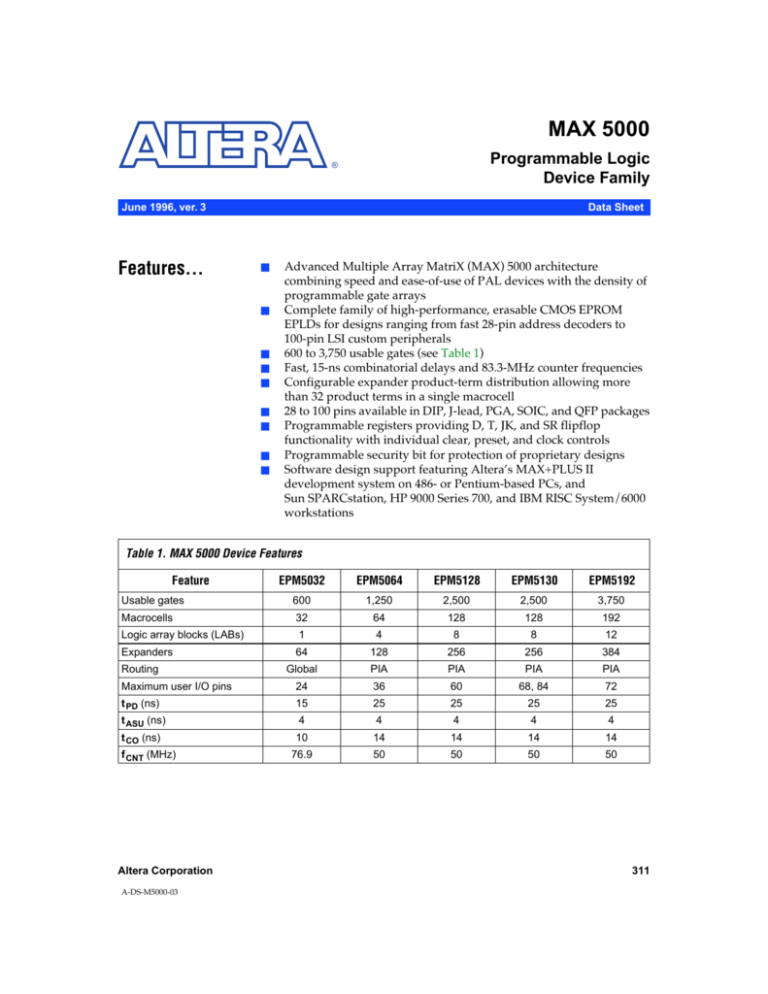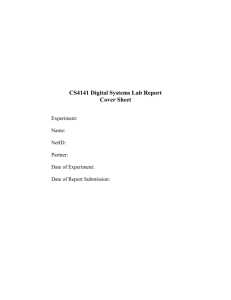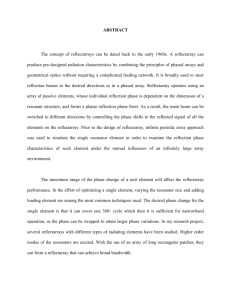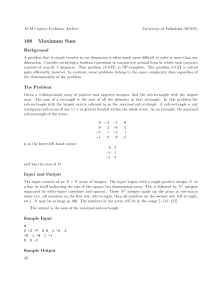
MAX 5000
Programmable Logic
Device Family
®
June 1996, ver. 3
Features...
Data Sheet
■
■
■
■
■
■
■
■
■
Advanced Multiple Array MatriX (MAX) 5000 architecture
combining speed and ease-of-use of PAL devices with the density of
programmable gate arrays
Complete family of high-performance, erasable CMOS EPROM
EPLDs for designs ranging from fast 28-pin address decoders to
100-pin LSI custom peripherals
600 to 3,750 usable gates (see Table 1)
Fast, 15-ns combinatorial delays and 83.3-MHz counter frequencies
Configurable expander product-term distribution allowing more
than 32 product terms in a single macrocell
28 to 100 pins available in DIP, J-lead, PGA, SOIC, and QFP packages
Programmable registers providing D, T, JK, and SR flipflop
functionality with individual clear, preset, and clock controls
Programmable security bit for protection of proprietary designs
Software design support featuring Altera’s MAX+PLUS II
development system on 486- or Pentium-based PCs, and
Sun SPARCstation, HP 9000 Series 700, and IBM RISC System/6000
workstations
Table 1. MAX 5000 Device Features
Feature
EPM5032
EPM5064
EPM5128
EPM5130
EPM5192
Usable gates
600
1,250
2,500
2,500
3,750
Macrocells
32
64
128
128
192
Logic array blocks (LABs)
1
4
8
8
12
Expanders
64
128
256
256
384
Routing
Global
PIA
PIA
PIA
PIA
Maximum user I/O pins
24
36
60
68, 84
72
t PD (ns)
15
25
25
25
25
t ASU (ns)
4
4
4
4
4
t CO (ns)
10
14
14
14
14
76.9
50
50
50
50
f CNT (MHz)
Altera Corporation
A-DS-M5000-03
311
MAX 5000 Programmable Logic Device Family Data Sheet
...and More
Features
■
General
Description
The MAX 5000 family combines innovative architecture and advanced
process technologies to offer optimum performance, flexibility, and the
highest logic-to-pin ratio of any general-purpose programmable logic
device (PLD) family. The MAX 5000 family provides 600 to 3,750 usable
gates, pin-to-pin delays as fast as 15 ns, and counter frequencies of up to
83.3 MHz. See Table 2.
■
Programming support with Altera’s Master Programming Unit
(MPU) or programming hardware from other manufacturers
Additional design entry and simulation support provided by EDIF,
LPM, Verilog HDL, VHDL, and other interfaces to popular EDA tools
from manufacturers such as Cadence, Data I/O, Exemplar, Mentor
Graphics, MINC, OrCAD, Synopsys, VeriBest, and Viewlogic
Table 2. MAX 5000 Timing Parameter Availability
Device
EPM5032
Speed (tPD1)
15 ns
20 ns
25 ns
v
v
v
30 ns
35 ns
EPM5064
v
v
v
EPM5128
v
v
v
EPM5130
v
v
EPM5192
v
v
The MAX 5000 architecture supports 100% TTL emulation and
high-density integration of multiple SSI, MSI, and LSI logic functions. For
example, an EPM5192 device can replace over 100 74-series devices; it can
integrate complete subsystems into a single package, saving board area
and reducing power consumption. MAX 5000 EPLDs are available in a
wide range of packages (see Table 3), including the following:
■
■
■
■
■
312
Windowed ceramic and plastic dual in-line (CerDIP and PDIP)
Windowed ceramic and plastic J-lead chip carrier (JLCC and PLCC)
Windowed ceramic pin-grid array (PGA)
Plastic small-outline integrated circuit (SOIC)
Ceramic and plastic quad flat pack (CQFP and PQFP)
Altera Corporation
MAX 5000 Programmable Logic Device Family Data Sheet
Table 3. MAX 5000 Pin Count & Package Options
Device
Note (1)
Pin Count
28
84
100
EPM5130
JLCC
PLCC
PGA
PQFP
EPM5192
JLCC
PLCC
PGA
EPM5032
EPM5064
EPM5128
44
68
CerDIP
PDIP
JLCC
PLCC
SOIC
JLCC
PLCC
JLCC
PLCC
PGA
Note:
(1)
Contact Altera for up to date information on package availability.
MAX 5000 EPLDs have between 32 and 192 macrocells that are combined
into groups called logic array blocks (LABs). Each macrocell has a
programmable-AND/fixed-OR array and a configurable register that
provides D, T, JK, or SR operation with independent programmable clock,
clear, and preset functions. To build complex logic functions, each
macrocell can be supplemented with shareable expander product terms
(“shared expanders”) to provide more than 32 product terms per
macrocell.
The MAX 5000 family is supported by Altera’s MAX+PLUS II
development system, a single, integrated package that offers schematic,
text—including the Altera Hardware Description Language (AHDL)—
and waveform design entry; compilation and logic synthesis; simulation
and timing analysis; and device programming. MAX+PLUS II provides
EDIF 2 0 0 and 3 0 0, LPM, VHDL, Verilog HDL, and other interfaces for
additional design entry and simulation support from other industrystandard PC- and workstation-based EDA tools. MAX+PLUS II runs on
486- and Pentium-based PCs, and Sun SPARCstation, HP 9000 Series 700,
IBM RISC System/6000 workstations.
f
Altera Corporation
For more information, go to the MAX+PLUS II Programmable Logic
Development System & Software Data Sheet in this data book.
313
MAX 5000 Programmable Logic Device Family Data Sheet
Functional
Description
This section provides a functional description of MAX 5000 EPLDs, which
have the following architectural features:
■
■
■
■
■
■
Logic array blocks
Macrocells
Clocking options
Expander product terms
Programmable interconnect array
I/O control blocks
The MAX 5000 architecture is based on the concept of linking highperformance, flexible logic array modules called logic array blocks
(LABs). Multiple LABs are linked via the programmable interconnect
array (PIA), a global bus that is fed by all I/O pins and macrocells. In
addition to these basic elements, the MAX 5000 architecture includes 8 to
20 dedicated inputs, each of which can be used as a high-speed, generalpurpose input. Alternatively, one of the dedicated inputs can be used as a
high-speed global clock for registers.
Logic Array Blocks
MAX 5000 EPLDs contain 1 to 12 LABs. The EPM5032 has a single LAB,
while the EPM5064, EPM5128, EPM5130, and EPM5192 contain multiple
LABs. Each LAB consists of a macrocell array and an expander productterm array. See Figure 1. The number of macrocells and expanders in the
arrays varies with each device.
314
Altera Corporation
MAX 5000 Programmable Logic Device Family Data Sheet
Figure 1. MAX 5000 Architecture
8 to 20
Dedicated
Inputs
16
PIA
24
LAB Interconnect
PIA in
Multi-LAB
Devices Only
LAB A
Macrocell
Array
I/O
Control
Block
4 to 16
I/O Pins
per LAB
Expander
Product-Term
Array
Feedback from
I/O Pins to LAB
(Single-LAB
Devices)
to All Other LABs
Macrocells are the primary resource for logic implementation. Additional
logic capability is available from expanders, which can be used to
supplement the capabilities of any macrocell. The expander product-term
array consists of a group of unallocated, inverted product terms that can
be used and shared by all macrocells in the LAB to create combinatorial
and registered logic. These flexible macrocells and shareable expanders
facilitate variable product-term designs without the inflexibility of fixed
product-term architectures. All macrocell outputs are globally routed
within an LAB via the LAB interconnect. The outputs of the macrocells
also feed the I/O control block, which consists of groups of
programmable tri-state buffers and I/O pins. In the EPM5064, EPM5128,
EPM5130, and EPM5192 devices, multiple LABs are connected by a PIA.
All macrocells feed the PIA to provide efficient routing for high-fan-in
designs.
Altera Corporation
315
MAX 5000 Programmable Logic Device Family Data Sheet
Macrocells
The MAX 5000 macrocell consists of a programmable logic array and an
independently configurable register (see Figure 2). The register can be
programmed to emulate D, T, JK, or SR operation, as a flow-through latch,
or bypassed for combinatorial operation. Combinatorial logic is
implemented in the programmable logic array, in which three product
terms that are ORed together feed one input to an XOR gate. The second
input to the XOR gate is used for complex XOR arithmetic logic functions
and for De Morgan’s inversion. The output of the XOR gate feeds the
programmable register or bypasses it for combinatorial operation.
Figure 2. MAX 5000 Device Macrocell
Logic Array
Output Enable
Global Clock
(One Per LAB)
Preset
Programmable
Register
D
PRN
Q
to I/O
Control
Block
CLRN
Array Clock
Clear
Macrocell Feedback
I/O Feedback
24 Programmable
8 or 20
32 or 64
Interconnect Signals
Dedicated
Expander
Inputs (Multi-LAB Devices Only) Product Terms
Additional product terms—called secondary product terms—are used to
control the output enable, preset, clear, and clock signals. Preset and clear
product terms drive the active-low asynchronous preset and
asynchronous clear inputs to the configurable flipflop. The clock product
term allows each register to have an independent clock and supports
positive- and negative-edge-triggered operation. Macrocells that drive an
output pin can use the output enable product term to control the activehigh tri-state buffer in the I/O control block.
The MAX 5000 macrocell configurability makes it possible to efficiently
integrate complete subsystems into a single device.
316
Altera Corporation
MAX 5000 Programmable Logic Device Family Data Sheet
Clocking Options
Each LAB supports either global or array clocking. Global clocking is
provided by a dedicated clock signal (CLK) that offers fast clock-to-output
delay times. Since each LAB has one global clock, all flipflop clocks within
the LAB can be positive-edge-triggered from the CLK pin. If the CLK pin is
not used as a global clock, it can be used as a high-speed dedicated input.
In the array clocking mode, each flipflop is clocked by a product term.
Any input pin or internal logic can be used as a clock source. Array
clocking allows each flipflop to be configured for positive- or negativeedge-triggered operation, giving the macrocell increased flexibility.
Systems that require multiple clocks are easily integrated into MAX 5000
EPLDs.
Each flipflop in an LAB can be clocked by a different array-generated
clock; however, global and array clocking modes cannot be mixed in the
same LAB.
Expander Product Terms
While most logic functions can be implemented with the product terms
available in each macrocell, some logic functions are more complex and
require additional product terms. Although additional macrocells can be
used to supply the needed logic resources, the MAX 5000 architecture can
also use shared expander product terms that provide additional product
terms directly to any macrocell in the same LAB. These expanders help
ensure that logic is synthesized with the fewest possible logic resources to
obtain the fastest possible speed.
Each LAB has 32 shared expanders (except for the EPM5032 device, which
has 64). The expanders can be viewed as a pool of uncommitted product
terms. The expander product-term array (see Figure 3) contains
unallocated, inverted product terms that feed the macrocell array.
Expanders can be used and shared by all product terms in the LAB.
Wherever extra logic is needed (including register control functions),
expanders can be used to implement the logic. These expanders provide
the flexibility to implement register- and product-term-intensive designs
in MAX 5000 EPLDs.
Altera Corporation
317
MAX 5000 Programmable Logic Device Family Data Sheet
Figure 3. Expander Product Terms
to Macrocell Array
8 or 20
Dedicated
Inputs
24 Programmable
Macrocell
Interconnect Signals
Feed backs
(Multi-LAB Devices Only)
32 or 64
Expander
Product Terms
Expanders are fed by all signals in the LAB. One expander can feed all
macrocells in the LAB or multiple product terms in the same macrocell.
Since expanders also feed the secondary product terms of each macrocell,
complex logic functions can be implemented without using additional
macrocells. Expanders can also be cross-coupled to build additional
flipflops, latches, or input registers. A small delay (t SEXP) is incurred
when shared expanders are used.
Programmable Interconnect Array
The higher-density MAX 5000 devices—EPM5064, EPM5128, EPM5130,
and EPM5192—use a programmable interconnect array (PIA) to route
signals between the various LABs. The PIA, which is fed by all macrocell
and I/O pin feedbacks, routes only the signals required for implementing
logic in an LAB. While the routing delays of channel-based routing
schemes in masked or field-programmable gate arrays (FPGAs) are
cumulative, variable, and path-dependent, the MAX 5000 PIA has a fixed
delay. The PIA thus eliminates skew between signals and makes timing
performance easy to predict.
I/O Control Blocks
Each LAB has an I/O control block that allows each I/O pin to be
individually configured for input, output, or bidirectional operation. See
Figure 4. The I/O control block is fed by the macrocell array. A dedicated
macrocell product term controls a tri-state buffer, which drives the I/O
pin.
318
Altera Corporation
MAX 5000 Programmable Logic Device Family Data Sheet
Figure 4. I/O Control Block
OE Control (from Macrocell Product Term)
from Macrocell Array
Macrocell Feedback
I/O Pin Feedback
The MAX 5000 architecture provides dual I/O feedback in which
macrocell and I/O pin feedbacks are independent, allowing maximum
flexibility. When an I/O pin is configured as an input, the associated
macrocell can be used for buried logic. Using an I/O pin as an input in
single-LAB devices reduces the number of available expanders by two. In
multi-LAB devices, I/O pins feed the PIA directly.
Design Security
All MAX 5000 EPLDs contain a programmable security bit that controls
access to the data programmed into the device. When this bit is
programmed, a proprietary design implemented in the device cannot be
copied or retrieved. This feature provides a high level of design security,
since programmed data within EPROM cells is invisible. The security bit
that controls this function, as well as all other program data, is reset when
an EPLD is erased.
Generic Testing
MAX 5000 EPLDs are fully functionally tested. Complete testing of each
programmable EPROM bit and all internal logic elements ensures 100%
programming yield. AC test measurements are taken under conditions
equivalent to those in Figure 5.
Figure 5. AC Test Conditions
Power supply transients can affect AC
measurements. Simultaneous transitions
of multiple outputs should be avoided for
accurate measurement. Threshold tests
must not be performed under AC
conditions. Large-amplitude, fast groundcurrent transients normally occur as the
device outputs discharge the load
capacitances. When these transients flow
through the parasitic inductance between
the device ground pin and the test system
ground, significant reductions in
observable noise immunity can result.
Altera Corporation
VCC
464 Ω
Device
Output
250 Ω
to Test
System
C1 (includes JIG
capacitance)
Device input
rise and fall
times < 3 ns
319
MAX 5000 Programmable Logic Device Family Data Sheet
Test patterns can be used and then erased during early stages of the device
production flow. EPROM-based EPLDs in one-time-programmable
windowless packages also contain on-board logic test circuitry to allow
verification of function and AC specifications during the production flow.
Device
Programming
f
All MAX 5000 EPLDs can be programmed on 486- and Pentium-based
PCs with an Altera Logic Programmer card, the Master Programming
Unit (MPU), and the appropriate device adapter. The MPU checks
continuity to ensure adequate electrical contact between the adapter and
the device.
For more information, see Altera Programming Hardware Data Sheet in this
data book.
MAX+PLUS II software can use text- or waveform-format test vectors
created with the MAX+PLUS II Text or Waveform Editor to test a
programmed device. For added design verification, designers can
perform functional testing to compare the functional behavior of a
MAX 5000 EPLD with the simulation results. (This feature requires a
device adapter with the “PLM-” prefix.)
Data I/O and other programming hardware manufacturers also offer
programming support for Altera devices.
f
QFP Carrier &
Development
Socket
f
320
For more information, see Programming Hardware Manufacturers in this
data book.
MAX 5000 devices in 100-pin QFP packages are shipped in special plastic
carriers to protect the fragile QFP leads. Each carrier can be used with a
prototype development socket and programming hardware available
from Altera or Data I/O. This carrier technology makes it possible to
program, test, erase, and reprogram devices without exposing the leads to
mechanical stress.
For detailed information and carrier dimensions, refer to theQFP Carrier
& Development Socket Data Sheet in this data book.
Altera Corporation
MAX 5000 Programmable Logic Device Family Data Sheet
MAX 5000 Device Absolute Maximum Ratings
Symbol
Note (1)
Parameter
Conditions
Min
Max
Unit
V
V CC
Supply voltage
With respect to GND
–2.0
7.0
VI
DC input voltage
Note (2)
–2.0
7.0
V
I OUT
DC output current, per pin
–25
25
mA
T STG
Storage temperature
No bias
–65
135
°C
–65
T AMB
Ambient temperature
Under bias
135
°C
TJ
Junction temperature
Ceramic packages, under bias
150
°C
Plastic packages, under bias
135
°C
Max
Unit
MAX 5000 Device Recommended Operating Conditions
Symbol
Parameter
Conditions
Min
Notes (3), (4)
V CC
Supply voltage
VI
Input voltage
0
V CC
VO
Output voltage
0
V CC
V
TA
Operating temperature
For commercial use
0
70
°C
TA
Operating temperature
For industrial use
85
°C
tR
Input rise time
100
ns
tF
Input fall time
100
ns
MAX 5000 Device DC Operating Conditions
Symbol
High-level input voltage
–40
V
V
Note (5)
Parameter
V IH
4.75 (4.5) 5.25 (5.5)
Conditions
Note (3)
V IL
Low-level input voltage
V OH
High-level TTL output voltage
I OH = –4 mA DC, Note (6)
V OL
Low-level output voltage
I OL = 8 mA DC, Note (6)
II
Input leakage current
V I = V CC or GND
I OZ
Tri-state output off-state current
V O = V CC or GND
Min
Max
Unit
2.0
Typ
V C C + 0.3
V
–0.3
0.8
V
2.4
V
0.45
V
–10
10
µA
–40
40
µA
Max
Unit
EPM5032 MAX 5000 Device Capacitance
Symbol
Parameter
Conditions
Min
C IN
Input pin capacitance
V IN = 0 V, f = 1.0 MHz
10
pF
C IO
I/O pin capacitance
V OUT = 0 V, f = 1.0 MHz
12
pF
Max
Unit
EPM5064, EPM5128, EPM5130 & EPM5192 MAX 5000 Device Capacitance
Symbol
Parameter
Conditions
Min
C IN
Input pin capacitance
V IN = 0 V, f = 1.0 MHz
10
pF
C I/O
I/O pin capacitance
V OUT = 0 V, f = 1.0 MHz
20
pF
Altera Corporation
321
MAX 5000 Programmable Logic Device Family Data Sheet
Notes to tables:
(1) See Operating Requirements for Altera Devices Data Sheet in this data book.
(2)
(3)
(4)
(5)
(6)
Minimum DC input is –0.3 V. During transitions, the inputs may undershoot to
–2.0 V or overshoot to 7.0 V for periods shorter than 20 ns under no-load conditions.
Numbers in parentheses are for industrial-temperature-range versions.
Maximum VCC rise time for MAX 5000 devices is 10 ms.
Typical values are for TA = 25° C and VCC = 5.0 V.
The IOH parameter refers to high-level TTL output current; the IOL parameter refers
to low-level TTL output current.
Figure 6 shows typical output drive characteristics of MAX 5000 devices.
Figure 6. Output Drive Characteristics of MAX 5000 Devices
IO
Output Current (mA) Typ.
100
IOL
80
VCC = 5.0 V
Room Temp.
60
40
IOH
20
0.45
1
2
3
4
5
VO Output Voltage (V)
Timing Model
322
MAX 5000 EPLD timing can be analyzed with the MAX+PLUS II
software, with a variety of other industry-standard EDA simulators and
timing analyzers, or with the timing model shown in Figure 7. MAX 5000
EPLDs have fixed internal delays that allow the user to determine the
worst-case timing for any design. MAX+PLUS II provides timing
simulation, point-to-point delay prediction, and detailed timing analysis
for system-level performance evaluation.
Altera Corporation
MAX 5000 Programmable Logic Device Family Data Sheet
Figure 7. MAX 5000 Timing Model
Single-LAB EPLDs
Shared Expander
Delay
tSEXP
Logic Array
Control Delay
tLAC
Input
Delay
tIN
Logic Array
Delay
tLAD
tRD
tCOMB
tLATCH
tCLR
tPRE
tSU
tH
Global
Clock Delay
tICS
I/O
Delay
tIO
Register
Delay
Output
Delay
tOD
tXZ
tZX
Array Clock
Delay
tIC
Feedback
Delay
tFD
Multi-LAB EPLDs
Shared Expander
Delay
tSEXP
Logic Array
Control Delay
tLAC
Input
Delay
tIN
Logic Array
Delay
tLAD
Global Clock
Delay
tICS
tRD
tCOMB
tLATCH
tCLR
tPRE
tSU
tH
Output
Delay
tOD
tXZ
tZX
Array Clock
Delay
tIC
PIA
Delay
tPIA
I/O
Delay
tIO
Altera Corporation
Register
Delay
Feedback
Delay
tFD
323
MAX 5000 Programmable Logic Device Family Data Sheet
Timing information can be derived from the timing model and parameters
for a particular EPLD. External timing parameters are calculated with the
sum of internal parameters and represent pin-to-pin timing delays.
Figure 8 shows the internal timing relationship for internal and external
delay parameters.
f
324
For more information on EPLD timing, refer to Application Note 78
(Understanding MAX 7000, MAX 5000 & Classic Timing) in this data book.
Altera Corporation
MAX 5000 Programmable Logic Device Family Data Sheet
Figure 8. Switching Waveforms
Input Mode
In multi-LAB EPLDs, I/O
pins that are used as
inputs traverse the PIA.
tI N
Input Pin
tI O
t R & t F < 3 ns.
Inputs are driven at
3 V for a logic high and
0 V for a logic low.
All timing characteristics
are measured at 1.5 V.
I/O Pin
tSEXP
Expander Array
Delay
tLAC, tLAD
Logic Array
Input
tCOMB
Logic Array
Output
tOD
Output Pin
Array Clock Mode
tACH
tR
Clock Pin
tACL
tF
tI N
Clock into
Logic Array
tI C
Clock from
Logic Array
tSU
tH
Data from
Logic Array
tRD, t LATCH
tCLR, tPRE
tFD
tFD
Register Output to
Local LAB Logic Array
tPI A
Register Output
to another LAB
Global Clock Mode
tCH
tR
Global Clock Pin
Global Clock
at Register
tI N
tSU
tCL
tF
tI C S
tH
Data from
Logic Array
Output Mode
Clock from
Logic Array
Data from
Logic Array
Output Pin
Altera Corporation
tRD
tOD
tXZ
tZX
High-Impedance
State
325
MAX 5000 Programmable Logic Device Family Data Sheet
EPM5032 AC Operating Conditions
Note (1)
External Timing Parameters
Symbol
Parameter
Conditions
EPM5032-15
EPM5032-20
EPM5032-25
Min
Min
Min
Max
Max
Max Unit
t PD1
Input to non-registered output
C1 = 35 pF
15
20
25
t PD2
I/O input to non-registered output
C1 = 35 pF
15
20
25
t SU
Global clock setup time
tH
Global clock hold time
t CO1
Global clock to output delay
t CH
Global clock high time
6
7
8
ns
t CL
Global clock low time
6
7
8
ns
t ASU
Array clock setup time
5
6
8
ns
t AH
Array clock hold time
5
6
8
ns
t ACO1
Array clock to output delay
C1 = 35 pF
t ACH
Array clock high time
Note (3)
t ACL
Array clock low time
t ODH
Output data hold time after clock
t CNT
Min. global clock period
f CNT
Max. internal global clock frequency
9
12
0
C1 = 35 pF
C1 = 35 pF (2)
15
0
10
15
ns
15
18
ns
ns
0
12
ns
22
ns
ns
6
7
9
ns
7
9
11
ns
1
1
1
ns
13
Note (4)
76.9
16
62.5
20
50
ns
MHz
t ACNT
Min. array clock period
f ACNT
Max. internal array clock frequency
Note (4)
76.9
62.5
50
MHz
f MAX
Max. clock frequency
Note (5)
83.3
71.4
62.5
MHz
326
13
16
20
ns
Altera Corporation
MAX 5000 Programmable Logic Device Family Data Sheet
Internal Timing Parameters
Symbol
Note (6)
Parameter
Conditions
EPM5032-15
EPM5032-20
EPM5032-25
Min
Min
Min
Max
Max
Max Unit
t IN
Input pad and buffer delay
3
5
7
t IO
I/O input pad and buffer delay
3
5
7
ns
tSEXP
Expander array delay
8
10
15
ns
t LAD
Logic array delay
7
10
13
ns
t LAC
Logic control array delay
4
4
4
ns
t OD
Output buffer and pad delay
C1 = 35 pF
4
4
4
ns
t ZX
Output buffer enable delay
C1 = 35 pF
7
7
7
ns
t XZ
Output buffer disable delay
C1 = 5 pF
t SU
Register setup time
t LATCH
Flow-through latch delay
1
1
1
t RD
Register delay
1
1
1
ns
t COMB
Combinatorial delay
1
1
1
ns
tH
Register hold time
t IC
Array clock delay
7
8
10
ns
t ICS
Global clock delay
2
2
3
ns
t FD
Feedback delay
1
1
1
ns
t PRE
Register preset time
5
6
9
ns
t CLR
Register clear time
5
6
9
ns
Altera Corporation
7
4
7
4
5
7
5
8
ns
ns
ns
10
ns
ns
327
MAX 5000 Programmable Logic Device Family Data Sheet
EPM5064, EPM5128, EPM5130 & EPM5192 AC Operating Conditions
EPM5064-1 EPM5064-2
EPM5128-1 EPM5128-2
EPM5130-1
EPM5192-1
External Timing Parameters
Symbol
Parameter
Note (1)
Conditions
EPM5064
EPM5128
EPM5130
EPM5192
Min Max Min Max Min Max Unit
t PD1
Input to non-registered output
C1 = 35 pF
25
30
t PD2
I/O input to non-registered output
C1 = 35 pF
t SU
Global clock setup time
15
20
25
ns
tH
Global clock hold time
0
0
0
ns
t CO1
Global clock to output delay
t CH
Global clock high time
8
10
12.5
ns
t CL
Global clock low time
8
10
12.5
ns
t ASU
Array clock setup time
5
6
10
ns
t AH
Array clock hold time
t ACO1
Array clock to output delay
C1 = 35 pF
t ACH
Array clock high time
Note (3)
11
14
16
t ACL
Array clock low time
Note (3)
9
11
14
t CNT
Min. global clock period
40
C1 = 35 pF
45
14
6
16
8
25
C1 = 35 pF, Note (2)
ns
55
ns
20
10
30
20
35
ns
35
25
ns
ns
ns
ns
30
ns
t ODH
Output data hold time after clock
f CNT
Max. internal global clock frequency Note (4)
t ACNT
Min. array clock period
f ACNT
Max. internal array clock frequency
Note (4)
50
40
33.3
MHz
f MAX
Max. clock frequency
Note (3)
62.5
50
40
MHz
328
2
2
2
ns
50
40
33.3
MHz
20
25
30
ns
Altera Corporation
MAX 5000 Programmable Logic Device Family Data Sheet
Internal Timing Parameters
Symbol
EPM5064-1 EPM5064-2
EPM5128-1 EPM5128-2
EPM5130-1
EPM5192-1
Note (6)
Parameter
Conditions
EPM5064
EPM5128
EPM5130
EPM5192
Min Max Min Max Min Max Unit
t IN
Input pad and buffer delay
5
7
11
t IO
I/O input pad and buffer delay
6
6
11
ns
tSEXP
Expander array delay
12
14
20
ns
t LAD
Logic array delay
12
14
14
ns
t LAC
Logic control array delay
10
12
13
ns
t OD
Output buffer and pad delay
C1 = 35 pF
5
5
6
ns
t ZX
Output buffer enable delay
C1 = 35 pF
10
11
13
ns
t XZ
Output buffer disable delay
C1 = 5 pF
10
11
13
ns
t SU
Register setup time
t LATCH
Flow-through latch delay
3
4
4
ns
t RD
Register delay
1
2
2
ns
t COMB
Combinatorial delay
3
4
4
ns
tH
Register hold time
t IC
Array clock delay
14
16
16
ns
t ICS
Global clock delay
3
2
1
ns
t FD
Feedback delay
1
1
2
ns
t PRE
Register preset time
5
6
7
ns
t CLR
Register clear time
5
6
7
ns
t PIA
Programmable interconnect array
delay
14
16
20
ns
6
8
4
12
6
ns
ns
8
ns
Notes to tables:
(1)
(2)
(3)
(4)
(5)
(6)
Operating conditions: VCC = 5 V ± 5%, TA = 0° C to 70° C for commercial use.
VCC = 5 V ± 10%, TA = –40° C to 85° C for industrial use.
This parameter is a guideline that is sample-tested only. It is based on extensive device characterization. This
parameter applies for both global and array clocking.
This parameter is measured with a positive-edge-triggered clock at the register. For negative-edge clocking, the
tACH and tACL parameters must be swapped.
For EPM5032 devices, this parameter is measured with a 32-bit counter programmed into each LAB. For EPM5064,
EPM5128, EPM5130, and EPM5192 devices, this parameter is measured with a 16-bit counter programmed into each
LAB. ICC is characterized at 0° C.
The fMAX values represent the highest frequency for pipelined data.
For information on internal timing parameters, refer to Application Note 78 (Understanding MAX 7000, MAX 5000 &
Classic Timing) in this data book.
Altera Corporation
329
MAX 5000 Programmable Logic Device Family Data Sheet
Figure 9 shows typical supply current versus frequency for MAX 5000
devices.
Figure 9. ICC vs. Frequency for MAX 5000 Devices (Part 1 of 2)
EPM5032
EPM5064
240
200
160
VCC = 5.0 V
Room Temp.
120
80
ICC Active (mA) Typ.
ICC Active (mA) Typ.
200
150
VCC = 5.0 V
Room Temp.
100
50
40
100 Hz 1 kHz
100 kHz 1 MHz 10 MHz 100 MHz
10 kHz
100 Hz 1 kHz
Frequency
10 kHz
100 kHz 1 MHz 10 MHz 100 MHz
Frequency
EPM5130
EPM5128
500
400
VCC = 5.0 V
Room Temp.
200
100
ICC Active (mA) Typ.
ICC Active (mA) Typ.
400
300
300
VCC = 5.0 V
Room Temp.
200
100
100 Hz
1 kHz
10 kHz
100 kHz 1 MHz 10 MHz 50 MHz
Frequency
330
100 Hz
1 kHz
10 kHz
100 kHz 1 MHz 10 MHz 50 MHz
Frequency
Altera Corporation
MAX 5000 Programmable Logic Device Family Data Sheet
Figure 9. ICC vs. Frequency for MAX 5000 Devices (Part 2 of 2)
EPM5192
500
ICC Active (mA) Typ.
400
VCC = 5.0 V
Room Temp.
300
200
100
100 Hz 1 kHz
10 kHz
100 kHz 1 MHz 10 MHz 50 MHz
Frequency
Device
Pin-Outs
Tables 4 through 13 show the pin names and numbers for the pins in each
MAX 5000 device package.
Table 4. EPM5032 Dedicated Pin-Outs
Pin Name
Altera Corporation
28-Pin J-Lead
28-Pin DIP
2
28-Pin SOIC
INPUT/CLK
9
INPUT
6, 7, 8, 20, 21, 22, 1, 13, 14, 15, 16,
23
27, 28
1, 13, 14, 15, 16,
27, 28
2
GND
15, 28
8, 21
8, 21
VCC
1, 14
7, 22
7, 22
331
MAX 5000 Programmable Logic Device Family Data Sheet
Table 5. EPM5032 I/O Pin-Outs
MC
28-Pin
J-Lead
28-Pin
DIP
28-Pin
SOIC
MC
28-Pin
J-Lead
28-Pin
DIP
28-Pin
SOIC
10
3
3
17
24
17
17
2
–
–
–
18
–
–
–
3
11
4
4
19
25
18
18
4
–
–
–
20
–
–
–
5
12
5
5
21
26
19
19
6
–
–
–
22
–
–
–
7
13
6
6
23
27
20
20
8
–
–
–
24
–
–
–
23
1
9
16
9
9
25
2
23
10
–
–
–
26
–
–
–
11
17
10
10
27
3
24
24
12
–
–
–
28
–
–
–
13
18
11
11
29
4
25
25
14
–
–
–
30
–
–
–
15
19
12
12
31
5
26
26
16
–
–
–
32
–
–
–
Table 6. EPM5064 Dedicated Pin-Outs
Pin Name
332
44-Pin J-Lead
INPUT/CLK
34
INPUT
9, 11, 12, 13, 31, 33, 35
GND
10, 21, 32, 43
VCC
3, 14, 25, 36
Altera Corporation
MAX 5000 Programmable Logic Device Family Data Sheet
Table 7. EPM5064 I/O Pin-Outs
MC
Altera Corporation
LAB
44-Pin
J-Lead
MC
LAB
44-Pin
J-Lead
1
A
2
17
B
15
2
A
4
18
B
16
3
A
5
19
B
17
4
A
6
20
B
18
5
A
7
21
B
19
6
A
8
22
B
20
7
A
–
23
B
22
8
A
–
24
B
23
9
A
–
25
B
–
10
A
–
26
B
–
11
A
–
27
B
–
12
A
–
28
B
–
13
A
–
29
B
–
14
A
–
30
B
–
15
A
–
31
B
–
16
A
–
32
B
–
33
C
24
49
D
37
34
C
26
50
D
38
35
C
27
51
D
39
36
C
28
52
D
40
37
C
29
53
D
41
38
C
30
54
D
42
39
C
–
55
D
44
40
C
–
56
D
1
41
C
–
57
D
–
42
C
–
58
D
–
43
C
–
59
D
–
44
C
–
60
D
–
45
C
–
61
D
–
46
C
–
62
D
–
47
C
–
63
D
–
48
C
–
64
D
–
333
MAX 5000 Programmable Logic Device Family Data Sheet
Table 8. EPM5128 Dedicated Pin-Outs
Pin Name
68-Pin J-Lead
68-Pin PGA
INPUT/CLK
1
B6
INPUT
2, 32, 34, 35, 36, 66, 68
A6, L4, L5, L6, K6, A8, A7
GND
16, 33, 50, 67
B7, E2, G10, K5
VCC
3, 20, 37, 54
B5, E10, G2, K7
Table 9. EPM5128 I/O Pin-Outs (Part 1 of 3)
MC
334
LAB
68-Pin
J-Lead
68-Pin
PGA
MC
LAB
68-Pin
J-Lead
68-Pin
PGA
1
A
4
A5
17
B
12
C2
2
A
5
B4
18
B
13
C1
3
A
6
A4
19
B
14
D2
4
A
7
B3
20
B
15
D1
5
A
8
A3
21
B
17
6
A
9
A2
22
B
–
–
7
A
10
B2
23
B
–
–
8
A
11
B1
24
B
–
–
9
A
–
–
25
B
–
–
10
A
–
–
26
B
–
–
11
A
–
–
27
B
–
–
12
A
–
–
28
B
–
–
13
A
–
–
29
B
–
–
14
A
–
–
30
B
–
–
15
A
–
–
31
B
–
–
16
A
–
–
32
B
–
–
E1
Altera Corporation
MAX 5000 Programmable Logic Device Family Data Sheet
Table 9. EPM5128 I/O Pin-Outs (Part 2 of 3)
Altera Corporation
MC
LAB
68-Pin
J-Lead
68-Pin
PGA
MC
LAB
68-Pin
J-Lead
68-Pin
PGA
33
C
18
F2
49
D
24
J2
34
C
19
F1
50
D
25
J1
35
C
21
G1
51
D
26
K1
36
C
22
H2
52
D
27
K2
37
C
23
H1
53
D
28
L2
38
C
–
–
54
D
29
K3
39
C
–
–
55
D
30
L3
40
C
–
–
56
D
31
K4
41
C
–
–
57
D
–
–
42
C
–
–
58
D
–
–
43
C
–
–
59
D
–
–
44
C
–
–
60
D
–
–
45
C
–
–
61
D
–
–
46
C
–
–
62
D
–
–
47
C
–
–
63
D
–
–
48
C
–
–
64
D
–
–
65
E
38
L7
81
F
46
J10
66
E
39
K8
82
F
47
J11
67
E
40
L8
83
F
48
H10
68
E
41
K9
84
F
49
H11
69
E
42
L9
85
F
51
G11
70
E
43
L10
86
F
–
–
71
E
44
K10
87
F
–
–
72
E
45
K11
88
F
–
–
73
E
–
–
89
F
–
–
74
E
–
–
90
F
–
–
75
E
–
–
91
F
–
–
76
E
–
–
92
F
–
–
77
E
–
–
93
F
–
–
78
E
–
–
94
F
–
–
79
E
–
–
95
F
–
–
80
E
–
–
96
F
–
–
335
MAX 5000 Programmable Logic Device Family Data Sheet
Table 9. EPM5128 I/O Pin-Outs (Part 3 of 3)
MC
LAB
68-Pin
J-Lead
68-Pin
PGA
MC
LAB
68-Pin
J-Lead
68-Pin
PGA
97
G
52
F10
113
H
58
C10
98
G
53
F11
114
H
59
C11
99
G
55
E11
115
H
60
B11
100
G
56
D10
116
H
61
B10
101
G
57
D11
117
H
62
A10
102
G
–
–
118
H
63
B9
103
G
–
–
119
H
64
A9
104
G
–
–
120
H
65
B8
105
G
–
–
121
H
–
–
106
G
–
–
122
H
–
–
107
G
–
–
123
H
–
–
108
G
–
–
124
H
–
–
109
G
–
–
125
H
–
–
110
G
–
–
126
H
–
–
111
G
–
–
127
H
–
–
112
G
–
–
128
H
–
–
Table 10. EPM5130 Dedicated Pin-Outs
Pin Name
336
84-Pin J-Lead
100-Pin PGA
100-Pin PQFP
INPUT/CLK
1
C7
16
INPUT
2, 5, 6, 7, 36, 37,
38, 41, 42, 43, 44,
47, 48, 49, 78, 79,
80, 83, 84
A5, A7, A8, A9,
A10, B5, B7, B9,
C6, L7, L8, M5,
M7, M9, N4, N5,
N6, N7, N9
9, 10, 11, 14, 15,
16, 17, 20, 21, 22,
59, 60, 61, 64, 65,
66, 67, 70, 71, 72
GND
19, 20, 39, 40, 61,
62, 81, 82
B8, C8, F2, F3,
H11, H12, L6, M6
12, 13, 37, 38, 62,
63, 87, 88
VCC
3, 4, 23, 24, 45, 46, A6, B6, F12, F13,
65, 66
H1, H2, M8, N8
18, 19, 43, 44, 68,
69, 93, 94
Altera Corporation
MAX 5000 Programmable Logic Device Family Data Sheet
Table 11. EPM5130 I/O Pin-Outs (Part 1 of 2)
MC LAB 84-Pin 100-Pin 100-Pin MC LAB 84-Pin 100-Pin 100-Pin
J-Lead PGA
PQFP
J-Lead
PGA
PQFP
Altera Corporation
1
A
8
B13
1
17
B
14
A4
23
2
3
A
9
C12
2
18
B
15
B4
24
A
10
A13
3
19
B
16
A3
25
4
A
11
B12
4
20
B
17
A2
26
5
A
12
A12
5
21
B
18
B3
27
6
A
13
B11
6
22
B
21
A1
28
7
A
–
A11
7
23
B
–
B2
29
8
A
–
B10
8
24
B
–
B1
30
9
A
–
–
–
25
B
–
–
–
10
A
–
–
–
26
B
–
–
–
11
A
–
–
–
27
B
–
–
–
12
A
–
–
–
28
B
–
–
–
13
A
–
–
–
29
B
–
–
–
14
A
–
–
–
30
B
–
–
–
15
A
–
–
–
31
B
–
–
–
16
A
–
–
–
32
B
–
–
–
33
C
22
C2
31
49
D
30
G3
41
34
C
25
C1
32
50
D
31
G1
42
35
C
26
D2
33
51
D
32
H3
45
36
C
27
D1
34
52
D
33
J1
46
37
C
28
E2
35
53
D
34
J2
47
38
C
29
E1
36
54
D
35
K1
48
39
C
–
F1
39
55
D
–
K2
49
40
C
–
G2
40
56
D
–
L1
50
41
C
–
–
–
57
D
–
–
–
42
C
–
–
–
58
D
–
–
–
43
C
–
–
–
59
D
–
–
–
44
C
–
–
–
60
D
–
–
–
45
C
–
–
–
61
D
–
–
–
46
C
–
–
–
62
D
–
–
–
47
C
–
–
–
63
D
–
–
–
48
C
–
–
–
64
D
–
–
–
337
MAX 5000 Programmable Logic Device Family Data Sheet
Table 11. EPM5130 I/O Pin-Outs (Part 2 of 2)
MC LAB 84-Pin 100-Pin 100-Pin MC LAB 84-Pin 100-Pin 100-Pin
J-Lead PGA
PQFP
J-Lead
PGA
PQFP
338
65
E
50
M1
51
81
F
56
N10
73
66
E
51
L2
52
82
F
57
M10
74
67
E
52
N1
53
83
F
58
N11
75
68
E
53
M2
54
84
F
59
N12
76
69
E
54
N2
55
85
F
60
M11
77
70
E
55
M3
56
86
F
63
N13
78
71
E
–
N3
57
87
F
–
M12
79
72
E
–
M4
58
88
F
–
M13
80
73
E
–
–
–
89
F
–
–
–
74
E
–
–
–
90
F
–
–
–
75
E
–
–
–
91
F
–
–
–
76
E
–
–
–
92
F
–
–
–
77
E
–
–
–
93
F
–
–
–
78
E
–
–
–
94
F
–
–
–
79
E
–
–
–
95
F
–
–
–
80
E
–
–
–
96
F
–
–
–
97
G
64
L12
81
113
H
72
G11
91
98
G
67
L13
82
114
H
73
G13
92
95
99
G
68
K12
83
115
H
74
F11
100
G
69
K13
84
116
H
75
E13
96
101
G
70
J12
85
117
H
76
E12
97
102
G
71
J13
86
118
H
77
D13
98
103
G
–
H13
89
119
H
–
D12
99
104
G
–
G12
90
120
H
–
C13
100
105
G
–
–
–
121
H
–
–
–
106
G
–
–
–
122
H
–
–
–
107
G
–
–
–
123
H
–
–
–
108
G
–
–
–
124
H
–
–
–
109
G
–
–
–
125
H
–
–
–
110
G
–
–
–
126
H
–
–
–
111
G
–
–
–
127
H
–
–
–
112
G
–
–
–
128
H
–
–
–
Altera Corporation
MAX 5000 Programmable Logic Device Family Data Sheet
Table 12. EPM5192 Dedicated Pin-Outs
Pin Name
84-Pin J-Lead
84-Pin PGA
INPUT/CLK
1
A6
INPUT
2, 41, 42, 43, 44, 83, 84
A5, K6, J6, J7, L7, C7, C6
GND
18, 19, 39, 40, 60, 61, 81, A7, B7, E1, E2, G10, G11,
82
K5, L5
VCC
3, 24, 45, 66
B5, E10, G2, K7
Table 13. EPM5192 I/O Pin-Outs (Part 1 of 4)
MC
Altera Corporation
LAB
84-Pin
J-Lead
84-Pin
PGA
MC
LAB
84-Pin
J-Lead
84-Pin
PGA
C2
1
A
4
C5
17
B
12
2
A
5
A4
18
B
13
B1
3
A
6
B4
19
B
14
C1
4
A
7
A3
20
B
15
D2
5
A
8
A2
21
B
–
–
6
A
9
B3
22
B
–
–
7
A
10
A1
23
B
–
–
8
A
11
B2
24
B
–
–
9
A
–
–
25
B
–
–
10
A
–
–
26
B
–
–
11
A
–
–
27
B
–
–
12
A
–
–
28
B
–
–
13
A
–
–
29
B
–
–
14
A
–
–
30
B
–
–
15
A
–
–
31
B
–
–
16
A
–
–
32
B
–
–
339
MAX 5000 Programmable Logic Device Family Data Sheet
Table 13. EPM5192 I/O Pin-Outs (Part 2 of 4)
340
MC
LAB
84-Pin
J-Lead
84-Pin
PGA
MC
LAB
84-Pin
J-Lead
84-Pin
PGA
33
C
16
D1
49
D
22
G3
34
C
17
E3
50
D
23
G1
35
C
20
F2
51
D
25
F1
36
C
21
F3
52
D
26
H1
37
C
–
–
53
D
–
–
38
C
–
–
54
D
–
–
39
C
–
–
55
D
–
–
40
C
–
–
56
D
–
–
41
C
–
–
57
D
–
–
42
C
–
–
58
D
–
–
43
C
–
–
59
D
–
–
44
C
–
–
60
D
–
–
45
C
–
–
61
D
–
–
46
C
–
–
62
D
–
–
47
C
–
–
63
D
–
–
48
C
–
–
64
D
–
–
65
E
27
H2
81
F
31
L1
66
E
28
J1
82
F
32
K2
67
E
29
K1
83
F
33
K3
68
E
30
J2
84
F
34
L2
69
E
–
–
85
F
35
L3
70
E
–
–
86
F
36
K4
71
E
–
–
87
F
37
L4
72
E
–
–
88
F
38
J5
73
E
–
–
89
F
–
–
74
E
–
–
90
F
–
–
75
E
–
–
91
F
–
–
76
E
–
–
92
F
–
–
77
E
–
–
93
F
–
–
78
E
–
–
94
F
–
–
79
E
–
–
95
F
–
–
80
E
–
–
96
F
–
–
Altera Corporation
MAX 5000 Programmable Logic Device Family Data Sheet
Table 13. EPM5192 I/O Pin-Outs (Part 3 of 4)
Altera Corporation
MC
LAB
84-Pin
J-Lead
84-Pin
PGA
MC
LAB
84-Pin
J-Lead
84-Pin
PGA
97
G
46
L6
113
H
54
J10
98
99
G
47
L8
114
H
55
K11
G
48
K8
115
H
56
J11
100
G
49
L9
116
H
57
H10
101
G
50
L10
117
H
–
–
102
G
51
K9
118
H
–
–
103
G
52
L11
119
H
–
–
104
G
53
K10
120
H
–
–
105
G
–
–
121
H
–
–
106
G
–
–
122
H
–
–
107
G
–
–
123
H
–
–
108
G
–
–
124
H
–
–
109
G
–
–
125
H
–
–
110
G
–
–
126
H
–
–
111
G
–
–
127
H
–
–
112
G
–
–
128
H
–
–
129
I
58
H11
145
J
64
F11
130
I
59
F10
146
J
65
E11
131
I
62
G9
147
J
67
E9
132
I
63
F9
148
J
68
D11
133
I
–
–
149
J
–
–
134
I
–
–
150
J
–
–
135
I
–
–
151
J
–
–
136
I
–
–
152
J
–
–
137
I
–
–
153
J
–
–
138
I
–
–
154
J
–
–
139
I
–
–
155
J
–
–
140
I
–
–
156
J
–
–
141
I
–
–
157
J
–
–
142
I
–
–
158
J
–
–
143
I
–
–
159
J
–
–
144
I
–
–
160
J
–
–
341
MAX 5000 Programmable Logic Device Family Data Sheet
Table 13. EPM5192 I/O Pin-Outs (Part 4 of 4)
342
MC
LAB
84-Pin
J-Lead
84-Pin
PGA
MC
LAB
84-Pin
J-Lead
84-Pin
PGA
161
K
69
D10
177
L
73
A11
162
163
K
70
C11
178
L
74
B10
K
71
B11
179
L
75
B9
164
K
72
C10
180
L
76
A10
165
K
–
–
181
L
77
A9
166
K
–
–
182
L
78
B8
167
K
–
–
183
L
79
A8
168
K
–
–
184
L
80
B6
169
K
–
–
185
L
–
–
170
K
–
–
186
L
–
–
171
K
–
–
187
L
–
–
172
K
–
–
188
L
–
–
173
K
–
–
189
L
–
–
174
K
–
–
190
L
–
–
175
K
–
–
191
L
–
–
176
K
–
–
192
L
–
–
Altera Corporation
MAX 5000 Programmable Logic Device Family Data Sheet
Pin-Out
Diagrams
Figures 10 through 14 show the package pin-out diagrams of MAX 5000
devices.
Figure 10. EPM5032 Package Pin-Out Diagrams
26
I/O
I/O
4
25
I/O
I/O
5
24
I/O
4
3
2
1
I/O
3
I/O
INPUT
I/O
GND
INPUT
27
VCC
28
2
I/O
1
I/O
INPUT
INPUT/CLK
I/O
Package outlines not drawn to scale. Windows in ceramic packages only.
28
27
26
25
I/O
5
I/O
INPUT
6
24
I/O
I/O
6
23
I/O
VCC
7
22
VCC
INPUT
7
23
INPUT
GND
8
21
GND
INPUT
8
22
INPUT
I/O
9
20
I/O
14
25
I/O
I/O
5
24
I/O
I/O
6
23
I/O
VCC
7
22
VCC
GND
10
20
INPUT
I/O
9
20
18
I/O
I/O
I/O
10
19
17
I/O
16
INPUT
15
INPUT
I/O
I/O
I/O
11
18
I/O
I/O
12
17
I/O
INPUT
13
16
INPUT
INPUT
14
15
INPUT
EPM5032
11
12
13
14
28-Pin DIP
15
16
I/O
19
17
18
I/O
INPUT
4
21
I/O
13
I/O
I/O
8
I/O
INPUT
26
GND
I/O
12
3
28-Pin J-Lead
EPM5032
I/O
EPM5032
11
INPUT
I/O
I/O
I/O
I/O
INPUT
27
INPUT
GND
19
28
2
21
VCC
10
1
9
I/O
I/O
INPUT/CLK
INPUT
INPUT/CLK
28-Pin SOIC
Figure 11. EPM5064 Package Pin-Out Diagrams
I/O
2
1
I/O
I/O
3
I/O
VCC
4
I/O
I/O
5
GND
I/O
6
I/O
I/O
Package outline not drawn to scale. Windows in ceramic packages only.
44 43 42 41 40
I/O
7
39
I/O
I/O
8
38
I/O
INPUT
9
37
I/O
GND
10
36
VCC
INPUT
11
35
INPUT
INPUT
12
34
INPUT/CLK
INPUT
13
33
INPUT
VCC
14
32
GND
I/O
15
31
INPUT
I/O
16
30
I/O
I/O
17
29
I/O
EPM5064
I/O
I/O
I/O
VCC
I/O
I/O
I/O
GND
I/O
I/O
I/O
18 19 20 21 22 23 24 25 26 27 28
44-Pin J-Lead
Altera Corporation
343
MAX 5000 Programmable Logic Device Family Data Sheet
Figure 12. EPM5128 Package Pin-Out Diagrams
I/O
I/O
I/O
I/O
I/O
I/O
VCC
INPUT
INPUT/CLK
INPUT
GND
INPUT
I/O
I/O
I/O
I/O
I/O
Package outlines not drawn to scale. Windows in ceramic packages only.
L
9
8
7
6
5
4
3
2
1
68
67
66
65
64
63
62
61
10
11
12
13
14
15
16
17
18
19
20
21
22
23
24
25
26
I/O
I/O
I/O
I/O
I/O
I/O
VCC
I/O
I/O
I/O
GND
I/O
I/O
I/O
I/O
I/O
I/O
60
59
58
57
56
55
54
53
52
51
50
49
48
47
46
45
44
EPM5128
K
J
H
G
EPM5128
F
Bottom
View
E
D
C
B
A
27
28
29
30
31
32
33
34
35
36
37
38
39
40
41
42
43
I/O
I/O
I/O
I/O
I/O
I/O
GND
I/O
I/O
I/O
VCC
I/O
I/O
I/O
I/O
I/O
I/O
2
3
4
5
6
7
8
9
10 11
I/O
I/O
I/O
I/O
I/O
INPUT
GND
INPUT
INPUT
INPUT
VCC
I/O
I/O
I/O
I/O
I/O
I/O
1
68-Pin PGA
68-Pin J-Lead
Figure 13. EPM5130 Package Pin-Out Diagrams
I/O
I/O
I/O
I/O
INPUT
INPUT
INPUT
VCC
VCC
INPUT
INPUT/CLK
INPUT
INPUT
GND
GND
INPUT
INPUT
INPUT
I/O
I/O
I/O
Package outlines not drawn to scale. Windows in ceramic packages only.
Pin 1
11
10
9
8
7
6
5
4
3
2
1
84
83
82
81
80
79
78
77
76
75
12
13
14
15
16
17
18
19
20
21
22
23
24
25
26
27
28
29
30
31
32
EPM5130
74
73
72
71
70
69
68
67
66
65
64
63
62
61
60
59
58
57
56
55
54
I/O
I/O
I/O
I/O
I/O
I/O
I/O
I/O
VCC
VCC
I/O
I/O
GND
GND
I/O
I/O
I/O
I/O
I/O
I/O
I/O
M
L
K
J
H
EPM5130
G
Bottom
View
F
I/O
I/O
I/O
INPUT
INPUT
INPUT
GND
GND
INPUT
INPUT
INPUT
INPUT
VCC
VCC
INPUT
INPUT
INPUT
I/O
I/O
I/O
I/O
EPM5130
E
D
C
B
A
1
2
3
4
5
6
7
8
9 10 11 12 13
33
34
35
36
37
38
39
40
41
42
43
44
45
46
47
48
49
50
51
52
53
I/O
I/O
I/O
I/O
I/O
I/O
I/O
GND
GND
I/O
I/O
VCC
VCC
I/O
I/O
I/O
I/O
I/O
I/O
I/O
I/O
Pin 81
N
Pin 31
100-Pin PGA
Pin 51
100-Pin PQFP
84-Pin J-Lead
344
Altera Corporation
MAX 5000 Programmable Logic Device Family Data Sheet
Figure 14. EPM5192 Package Pin-Out Diagrams
I/O
I/O
I/O
I/O
I/O
I/O
I/O
I/O
VCC
INPUT
INPUT/CLK
INPUT
INPUT
GND
GND
I/O
I/O
I/O
I/O
I/O
I/O
Package outlines not drawn to scale. Windows in ceramic packages only.
L
11
10
9
8
7
6
5
4
3
2
1
84
83
82
81
80
79
78
77
76
75
12
13
14
15
16
17
18
19
20
21
22
23
24
25
26
27
28
29
30
31
32
EPM5192
74
73
72
71
70
69
68
67
66
65
64
63
62
61
60
59
58
57
56
55
54
I/O
I/O
I/O
I/O
I/O
I/O
I/O
I/O
VCC
I/O
I/O
I/O
I/O
GND
GND
I/O
I/O
I/O
I/O
I/O
I/O
K
J
H
G
EPM5192
F
Bottom
View
E
D
C
B
A
1
2
3
4
5
6
7
8
9
10 11
I/O
I/O
I/O
I/O
I/O
I/O
GND
GND
INPUT
INPUT
INPUT
INPUT
VCC
I/O
I/O
I/O
I/O
I/O
I/O
I/O
I/O
33
34
35
36
37
38
39
40
41
42
43
44
45
46
47
48
49
50
51
52
53
I/O
I/O
I/O
I/O
I/O
I/O
GND
GND
I/O
I/O
I/O
I/O
VCC
I/O
I/O
I/O
I/O
I/O
I/O
I/O
I/O
84-Pin PGA
84-Pin J-Lead
Altera Corporation
345
Copyright © 1995, 1996 Altera Corporation, 2610 Orchard Parkway,
San Jose, California 95134, USA, all rights reserved.
By accessing any information on this CD-ROM, you agree to be
bound by the terms of Altera’s Legal Notice.








